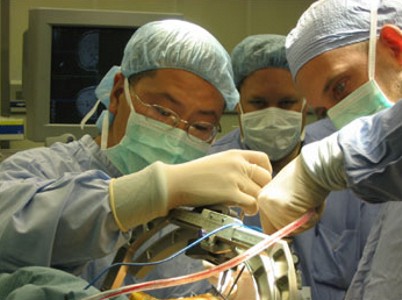.gif) VIARTIS � |
|||||
| � |
�PARKINSON'S DISEASE NEWS |
� | |||
|
� � � � |
15th February 2013 - New research DBS IS EFFECTIVE IN EARLIER PARKINSON'S DISEASE
New England Journal of Medicine [2013] 368 (7) : 610-622 (Schuepbach WM, Rau J,
Knudsen K, Volkmann J, Krack P, Timmermann L, H�lbig TD, Hesekamp H, Navarro SM,
Meier N, Falk D, Mehdorn M, Paschen S, Maarouf M, Barbe MT, Fink GR, Kupsch A,
Gruber D, Schneider GH, Seigneuret E, Kistner A, Chaynes P, Ory-Magne F, Brefel
Courbon C, Vesper J, Schnitzler A, Wojtecki L, Houeto JL, Bataille B, Malt�te D,
Damier P, Raoul S, Sixel-Doering F, Hellwig D, Gharabaghi A, Kr�ger R, Pinsker
MO, Amtage F, R�gis JM, Witjas T, Thobois S, Mertens P, Kloss M, Hartmann A,
Oertel WH, Post B, Speelman H, Agid Y, Schade-Brittinger C, Deuschl G; EARLYSTIM
Study Group)
Complete abstract In a two year clinical trial people with Parkinson's Disease and early motor complications (with an average age of 52 and a mean duration of Parkinson's Disease of 7.5 years) underwent neurostimulation plus medical therapy or only medical therapy alone. The primary end point was quality of life, as assessed with the use of the Parkinson's Disease Questionnaire (PDQ-39) with scores ranging from 0 to 100 and higher scores indicating worse function. For the primary outcome of quality of life, the mean score for the neurostimulation group improved by 7.8 points, and that for the medical-therapy group worsened by 0.2 points. Neurostimulation was superior to medical therapy with respect to motor disability, activities of daily living, L-dopa induced motor complications, and time with good mobility and no dyskinesia. Serious adverse events occurred in 54% of the people in the neurostimulation group and in 44% of those in the medical therapy group. Serious adverse events related to surgical implantation or the neurostimulation device occurred in 17% of people. For a printable version of this article click here.� For more news go to Parkinson's Disease News. �
|
� � � � � � � � � � � � � � � |
|||
|
� Parkinson's Disease News details all significant new research, news reports, new books, and new resources concerning Parkinson's Disease and those medical disorders that often coincide with Parkinson's Disease. It is compiled from an analysis of� all newly published research, news reports, new clinical trials, all newly published books, and new web sites. A summary and analysis of the new research are provided,� as well as links to the complete abstracts and news reports
� |
|||||
.gif) |
|||||
| � | |||||
| �2006-2013� Viartis | |||||
| � | |||||
| 2015-08-25 02:55:30 | |||||
| � | |||||
| [email protected] | |||||
 Researchers
assessed whether it would be suitable to use Subthalamic stimulation at an
earlier stage of Parkinson's Disease. Subthalamic stimulation, which is referred
to as DBS (Deep Brain Stimulation)
Researchers
assessed whether it would be suitable to use Subthalamic stimulation at an
earlier stage of Parkinson's Disease. Subthalamic stimulation, which is referred
to as DBS (Deep Brain Stimulation) E-MAIL NOTIFICATION : If you would like to be
notified by e-mail when any new articles are added to Parkinson's Disease News,� please merely
e-mail
E-MAIL NOTIFICATION : If you would like to be
notified by e-mail when any new articles are added to Parkinson's Disease News,� please merely
e-mail
 ����
����
 ���
���
 ���
���
 ����
����
 ����
����
 ����
����
 ����
����
 ���
���
